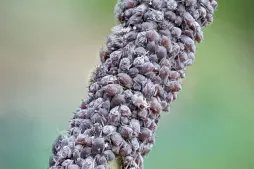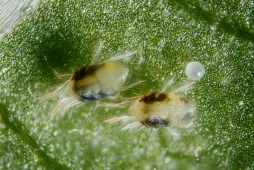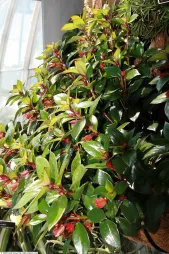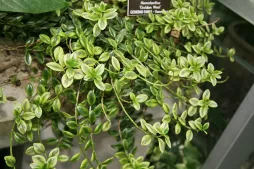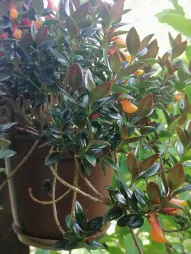Nematanthus gregarius, the goldfish plant
If, while walking through a Brazilian forest, you have the impression of seeing goldfish clinging to a tree, it's not due to too much Cachaça. You're probably in the presence of a Nematanthus gregarius. This plant of the Gesneriaceae family produces orange flowers that look just like Klaus from American Dad, minus the German accent!
How to recognize the goldfish plant, Nematanthus gregarius?
Goldfish plant, in Latin Nematanthus gregarius, is an epiphytic perennial with a bushy, drooping habit. It measures up to 50 centimetres in height with a one-metre spread.
Nematanthus gregarius has a woody stump. Its reddish-brown stems, on the other hand, are supple and herbaceous. They grow straight at first, before arching and drooping.
The fleshy, evergreen leaves are alternate and oval. They measure from two to four centimetres in length and are sharply veined. In the botanical variety, the foliage is shiny green on the upper surface, with a darker, matte underside. In addition, some blades have a brown line along the edge. Some cultivars, such as nematanthus gregarius variegata and nematanthus 'Golden West, have yellow and cream variegated leaves.
Nematanthus gregarius owes its nickname of goldfish plant to the shape and color of its inflorescence. The flowers are composed of five fused petals. They are rounded at the base and have a very narrow tip. The opening only reveals a yellow stamen. In Brazil, flowering takes place in autumn. But in the northern hemisphere, it occurs between March and October.
Goldfish flowers are orange. However, hybrids with yellow and red flowers, such as nematanthus 'Tropicana, or red and green, such as nematanthus 'Après, are also available.
Once pollinated, the flowers turn into a leathery capsule. It contains oblong seeds.
The plant is non-toxic to both pets and humans.
Our maintenance tips
Nematanthus gregarius require plenty of light to flower and thrive. Indoors, place your plant facing a window. From October to April, it won't mind direct sunlight. In summer, place it in semi-shade or in a spot that receives morning and evening light. Best of all? Take your plant outside in summer and place it in the shade of a tree.
Watering
Keep the soil slightly moist. Water only when the substrate is dry on the surface, for one or two centimeters.
Water with non-calcareous water at room temperature, without soaking the soil.
Thirty minutes after watering, empty any stagnant water from the cup. This will keep the roots dry and prevent them from rotting.
Spray
Mist foliage to increase humidity and repel pests. Always spray with rainwater. Tap water is too hard and leaves white marks on the leaves.
Repotting
In spring, transfer your Nematanthus gregarius to a larger pot, so that it can continue to grow.
Nematanthus gregarius require a light, well-drained substrate. Mix equal parts potting soil for epiphytic plants and potting soil for cacti and succulents.
Obtain a perforated pot. Pour a layer of your mixture into the bottom. Place your nematanthus gregarius in the center. Add potting soil and stop two centimetres before the edge to form a watering basin.
Press down and water generously.
Fertilization
You can stimulate the development of your plant during its growth phase, in spring and summer, with fertilizer.
Fertilize your Goldfish plant every month. Use a flowering plant fertilizer to stimulate flowering.
Cleaning
Using a clean, damp cloth, clean the top and bottom of the leaves. This removes dust and limits the appearance of pests.
Prune
Pruning your nematanthus gregarius encourages branching and helps maintain a compact habit.
Using a clean, sharp tool, such as a pair of scissors or pruning shears, cut the stem just above a node. Remove about a third of the length.
You can use this opportunity to remove any yellowed leaves.
Cutting
Cutting is carried out during the strong growth phase, generally in spring and early summer.
Cut a ten- to fifteen-centimeter stem with a clean, sharp tool. Remove the base leaves, leaving only the upper pairs.
Nematanthus gregarius appreciate well-draining soil. To meet their needs, prepare your own substrate by mixing potting soil for cacti and succulents with potting soil for epiphytic orchids.
Fill a perforated pot with your growing medium. Make a pilot hole and plant your cutting. You can place several stems in the same container for a fuller plant.
Water generously to encourage rooting.
Diseases / Threats
Information
| Family | Gesneriaceae - Gesneriaceae |
| Type | Nematanthus - Nematanthus |
| Species | Goldfish plant - Nematanthus gregarius |
| Lifecycle | Perennial |
| Foliage | Evergreen |
| Exposures | |
| Substrats | |
| Planting methods |
In pots In tubs Planter |
| Categories | |
| Tags |
Flowery Fritillary |
| Origin |
South America |
| Hardiness (USDA) | 11b |
| Leaf color |
|
| Flower colors |
|
Discover plants from the same family














